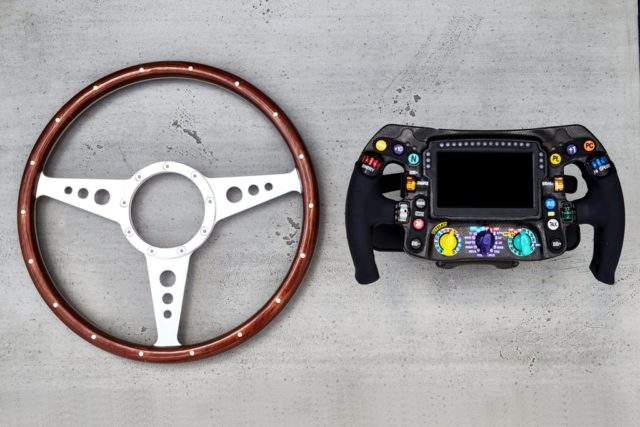Formula One cars are incredible machines. They’re fast, they’re beautiful, they’re the result of hundreds of people working together – and they are very complex. Yet, the drivers only have three ways of influencing the behaviour of the car – the throttle pedal, the brake pedal and the steering wheel. In a way, the term “ steering wheel” has become a bit misleading as “steering” is just one of many functions the device can perform these days. And it’s not shaped like a wheel either. In this week’s feature, the Mercedes team is taking a closer look at the complex command centres called steering wheels.
What are the main functions of a Formula One steering wheel?
In addition to the actual steering function, a Formula One steering wheel serves many purposes. One of the main functions is shifting. The shift paddles and the clutch are mounted on the backside of the steering wheel. It’s also a hub for information and communication. The driver can access crucial information on the central display, such as his engine speed, delta times to other cars or sensor information, for example, tyre temperatures. He can also confirm that he is coming into the pits with the press of a button and activate his radio.
A total of 25 LED lights on the steering wheel inform the driver of different situations – from his shift points to a rendering of the marshalling flags. The steering wheel is also used to influence certain car settings. For example, change the brake balance or adjust the differential (the amount of torque transfer between the rear wheels). Power unit settings, such as the all-important strategy mode, which determines the power output, are also selected on the steering wheel.

How can the team make sure the driver doesn’t hit a button by accident?
When driven in anger, a Formula One car is subject to violent speeds and heavy vibrations. [These are] not exactly ideal conditions to manipulate small buttons on a steering wheel. To make it even more difficult, the drivers have to operate the steering wheel while wearing gloves. To reduce the risk of accidentally hitting a button, the team has installed small plastic rims around certain buttons. Those guards can change on a race-by-race basis. They are particularly important for tight turns like the hairpin in Monaco when the drivers use the maximum steering angle. In addition to the guards around the buttons, the team uses high-reliability buttons that are also used on aircrafts, which require quite a strong tactile force. That way, the driver feels a solid click when he presses a button even with the gloves on.
How many steering wheel inputs does a driver make on a lap?
The amount and the type of inputs a driver makes depend on both the layout of the circuit and the situation in the session. On a “ regular” race lap around Silverstone a driver will typically do around 40 gearshifts (the quickest sequence in about 1.2 seconds for five downshifts going into Turn 3), two brake balance adjustments, two changes of display page and three differential adjustments – all of that in addition to the actual steering, of course.
How many potential combinations of settings are there?
There are 16 buttons, six rotary wheels and three rotary switches on the steering wheel – in addition to the shift pedals and the clutch. This means that there are hundreds of millions of potential combinations. But don’t worry – our drivers don’t have to test them all…
What does the development process of an F1 steering wheel look like and how involved are the drivers in that process?
When the main structure of today’s wheel was designed, the drivers were heavily involved in the design process. [That is] both in the ergonomics of the wheel and in the physical layout (from the overall shape of the wheel to the way the grips form at the bottom). The carbon structure is a long-term component that usually carries over for one or two years. If a new structure is introduced, the team will run a number of prototypes. [Then it will] bring them to the track for the drivers to try out in Friday practice. During the season, the team will change the grips, the button and the switch layout and the guards around the buttons – based on the individual demands of the driver and the track layout.
How important are ergonomics in the design process?
Very important – both in terms the feel of the steering wheel as well as certain elements of comfort. Because a Formula One car is extremely tightly packaged, there is not a whole lot of space in the cockpit. The bigger the steering wheel, the more it will cut in on the clearance of the knees underneath it or the clearance of the knuckles on the side of the tub.

How long does it take to build a new steering wheel?
The actual build process takes about two weeks of working hours (i.e. 80 hours). The majority of the parts are built in-house. The central display and the underlying circuit board are the only exceptions. These are common parts shared by all teams. All other components – the circuitry, the circuit boards, the steering, the carbon enclosure, the quick release, the electrical connectors – are custom build in the team’s factory in Brackley. The main materials used in a steering wheel are carbon fibre, fibreglass, titanium, silicon and copper. Over the course of a season, each driver will get three to four wheels. Mechanical designers, electrical designers and wiring technicians are involved in the design and build process.
What is the biggest challenge in designing and building an F1 steering wheel?
The steering wheel is a safety-critical component (internally known as a Class A component). As such, it has to undergo rigorous testing. [It is] similar to, for example, a suspension element or a piece of the survival cell. However, at the same time, it is a highly customised element. It can be changed on a race-by-race basis depending on the requirements of the drivers. The combination of these two requirements – highest level of diligence and constant changes – makes the design and build process very challenging.
How is a steering wheel serviced?
Steering wheels go through a service every two or three races. And just like every other component on the car, they have a certain maximum mileage. In the car, steering wheels are constantly vibrating. As they are considered safety-critical components, they undergo non-destructive testing (NDT). That is to make sure they don’t suffer from any sort of cracking. To check for cracks, the wheels are submerged into a low viscosity dye penetrant and left the soak. The dye penetrates any cracks, which when dry will show clearly under ultraviolet light. The steering wheels also undergo electrical testing, ultrasonic inspection and checks for water tightness. The grips and buttons are also checked on a regular basis. Every button only has a certain number of actuations it can survive.
2008 = ?
2014 = ?
2015 = ?
2016 = ?
2017 = ?
2018 = ❓@LewisHamilton ❤️s the #BritishGP! ?? pic.twitter.com/0wj60eHarc— Mercedes-AMG F1 (@MercedesAMGF1) July 4, 2018

































